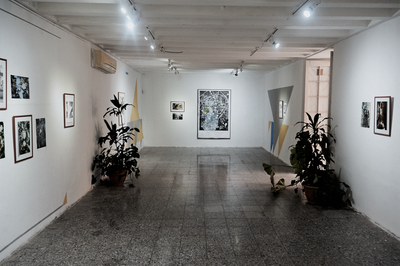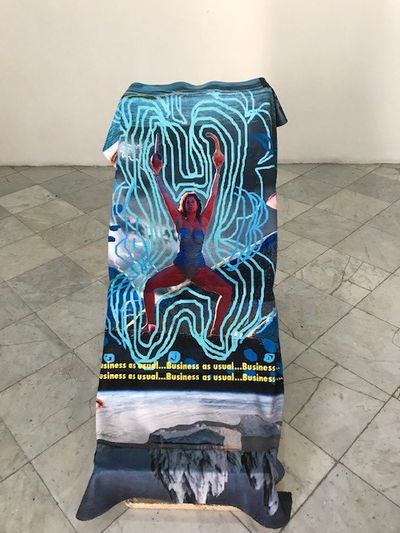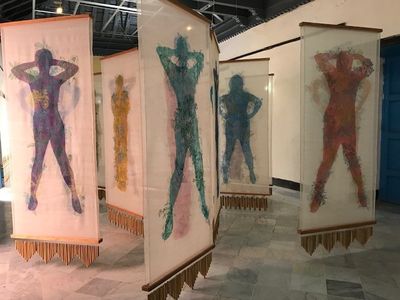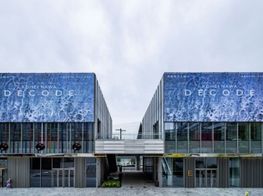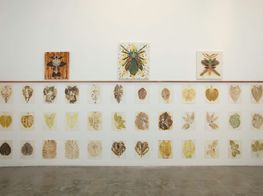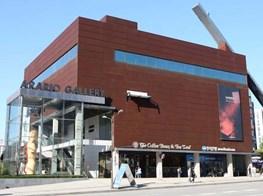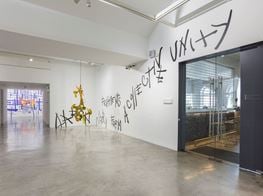Havana Biennial 2019: Constructing the Possible
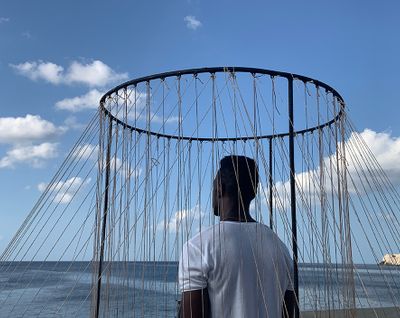
Carlos Martiel, La sangre de Caín (2019). Performance at 13th Havana Biennial, Havana (12 April–12 May 2019). Photo: Xiaoshi Vivian Vivian Qin.
I first visited Havana in November 2016, a few days after Fidel Castro died, and just under a year before Hurricane Irma hit Cuba in September 2017. Since then, much has changed, including the hand-painted signs that punctuate the journey from the airport to the city centre, which today do not celebrate the revolution so much as the 'Unidad y Compromiso', or 'Unity and Compromise'. Walking around the historic city, that compromise is clearly economic in nature, and tourism-focused. Yet things do not seem to have improved for many people in Havana, some of whom live on a wage of 55 euros per month.
Nothing in Cuba can be taken for granted, and what seems possible one moment becomes impossible in another. Arriving at the Centro de Arte Contemporáneo Wifredo Lam to collect my press accreditation for the 13th Havana Biennial (12 April–12 May 2019), for example, I was sent to the international press office in the neighbourhood of El Vedado, where I was told accreditation should have been arranged through the Cuban embassy in Berlin. Back at C.A.C. Wifredo Lam, I was told no press information was available. A programme PDF containing only vague information was emailed to me, which I downloaded after obtaining one hour of mobile data from the closest national telecommunications store. Without clear information, navigating the Biennial across the island, from Havana's historic centre to the provinces of Pinar del Río and Matanzas, where the artist María Magdalena Campos-Ponsput together a schedule of performances and talks called 'Ríos Intermitentes' (Intermittent Rivers), was a challenge. The experience gave weight to the aspirations coded into the title of this thirteenth edition: The Construction of the Possible.
Featuring 83 artists, the 13th Havana Biennial was curated by a committee of seven curators: Margarita González Lorente, Nelson Herrera Ysla, José Manuel Noceda Fernández, Ibis Hernández Abascal, Margarita Sánchez Prieto, José Héctor Fernández Portal, and Lisset Alonso Compte. The show doesn't have a central theme, but is conceived as a series of interventions in dialogue with the city, the island, and its recent history. In his curatorial essay 'The multiple constructions of the (im)possible', curator Nelson Herrera Ysla, who co-founded C.A.C. Wifredo Lam as well as the Biennial, writes: 'The Havana Biennial is being held in the midst of difficult circumstances.' This is exactly how the Biennial feels. It was actually supposed to take place in 2017, but was delayed indefinitely by the government following the catastrophic events of Hurricane Irma, which badly hit parts of the country already strangled by economic hardship and an uncertain political future. In protest against this decision, a group of independent Cuban artists, including Tania Bruguera and Luis Manuel Otero Alcántara, organised an independent #00 Havana Biennial in 2018, which was accused of 'distorting Cuba's cultural policies'.
Who is the traitor? The artists whose dissent is seen by the government as a sign of betrayal, or the government itself, whose values of revolutionary freedom, equality, and justice contradict their repressive, and rather paternalistic, behaviours?
It is a well-known fact that in Cuba, artists and cultural producers have repeatedly been ostracised, and in some cases jailed for their critical position towards politics. Last year, the newly instated government of president Miguel Díaz-Canel approved Decree 349, which essentially grants the state full control over artistic production in the country, thus further limiting the freedom of artists and cultural producers. The artists protesting the Decree have been punished for speaking up against a government unwilling to make a compromise with its citizens. I am sure there is more to what my limited knowledge of this place can allow me to understand, but it seems that the Havana Biennial could have also been titled Despite all Odds, since it is happening amid aplethora of impossibilities, making the organisers' effort particularly laudable, especially in the face of reduced budgets and political controversy.
Although there is no central theme, one of the emerging threads in the exhibition overall is a preoccupation with ecology and its entanglement with coloniality. At the Wifredo Lam Center of Contemporary Art, Haiti-born artist Adler Guerrier presents Untitled (We find moments in the landscape, ripe for replenishment, and in positions conducive to imagine anew), an installation composed of plants, collages, and a series of intimate photographs of plants found in the Caribbean landscape. For the artist, these plants have an emotional and affective value; they carry the traces of the Caribbean's colonial history, marking the presence of people who have suffered and resisted against colonial forces. In the same building, a video installation by Peruvian artist Maya Watanabe, Stasis (2018), shows a magnified close-up of the squamous body of a frozen carp. The title refers to 'biostasis'—a state in which an organism suspends metabolic activity in order to adapt to changes in the external environment, such as low temperatures in water in the case of carp, thus existing in a limbo of sorts, between life and death, resistance and survival. Watanabe's piece is a good metaphor for the state in which Cuba seems to exist, between the weight of years of isolation and a dying economy, and the vitality and survival skills of its inhabitants whose existence is characterised by a perennial state of precarity.
In another venue of the old city, the Casa de Simón Bolívar, the video installation entre un susurro y el llanto (between a whisper and a cry) (2019) by Barbados-born, Glasgow-based artist Alberta Whittle stands out for the way it weaves together, in a poetic manner, questions of ecology, survival, colonial violence, and the collective power of healing. The installation is composed of several pieces: a series of beach towels printed either with a banknote of one hundred U.S. dollars or with a digital collage of a meteorological map with the artist performing what looks like a ritual dance in the middle of it and the sentence 'business as usual' repeated multiple times. The towels are leaning against a series of precarious support structures made of raw construction material; what looks like a shrine made of the same plastic blankets used in the aftermath of catastrophes. A video of found and made footages ties the different parts of the installation together, showing sequences from a collective religious ritual, images of the artist on a boat at sea, a woman dancing, the landscape, and a weather forecast. Influenced by the work on the afterlife of slavery by Christina Sharpe, and Barbadian poet Kamau Brathwaite's Tidalectics, which exposes the performativity of sound as it carries the memories of a transoceanic life, Whittle's work is a multifaceted reflection on questions of survival, resistance to zombification, and the possibilities of healing the wounds of historical traumas and the violence inflicted yesterday as today upon Africans and the people of African descents.
Another thread that can be traced in this exhibition is the labour performed by women on a daily basis to guarantee the unity and survival of their families as much as of the nation. At the Casa de Asia, Geraldine Javier's installation, Spinning Women (2018–2019) is composed of 20 human-sized structures made of bamboo and thin white fabric embroidered with floral patterns on which the contours of human figures have been drawn in different colours. The installation pays homage to the many anonymous Filipino women coming from the community of Ibabao, in the province of Batangas, where the artist lives, who perform domestic and other types of work to support and sustain their families. When the wind blows, these half-human, half-plant figures produce music, as suspended to the bottom of each canvas is a traditional bamboo flute. On the wall is a map recording the names and professions of each of these women: Maricar Remo, occasional dealer in beauty products; Cheir-Lynn de la Roca, cook and laundry woman; Lilia Ortega Jaime, local healer and caretaker of children; Crenesa Medina, house-cleaner. In a similar vein, the work of Mexican artist Tania Candiani, Del Sonido de la Labor (The Sound of Labour) (2019), which consists of four pieces of music performed by local women in the spaces of an old factory in old Havana, addresses feminine labour.
One of the highlights of Detrás del Muro (Behind the Wall), a project of public interventions staged on the beautiful sea boulevard of El Malecón, is the durational performance by Cuban artist Carlos Martiel, titled La sangre de Caín (Caín's blood). Martiel has developed a distinct performative language made of disarmingly simple, yet particularly potent gestures that often test the limits of physical endurance under oft-extreme conditions. For his performative intervention for the Havana Biennial, Martiel has created a circular structure made of metal and stretched threads dyed with the blood of some of the artists involved in the protest against the Decree 349, who, in an act of solidarity, the artist has invited to contribute to his work. Dressed in white, Martiel stands inside this prison without walls, facing the sea, under a burning sun, becoming an object of contemplation, but also a subject of endurance and resistance. Who is the traitor? The artists whose dissent is seen by the government as a sign of betrayal, or the government itself, whose values of revolutionary freedom, equality, and justice contradict their repressive, and rather paternalistic, behaviours? Martiel's evocative performance opens a space for contemplation, amid the intense noise and the chaos that seems to have taken hold of the country as it moves toward an unknown future. As if to suggest that, at this important historical juncture, it is time to take a moment before turning.
In many ways, this edition of the Havana Biennial is an act of survival; the patient and tireless work of the many actors involved in making this important event possible, and who continue to believe in the possibilities of putting together a show of this scale, despite the adversities coming from all sides. For the international visitor like myself, the exhibition is hard to navigate, but this seems to be part of the impossible reality that the curators are referring to in the show itself. What is possible in such impossible conditions is the compromise that the curators of the Biennial have had to make. —[O]

